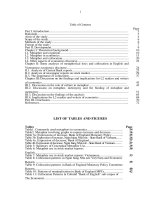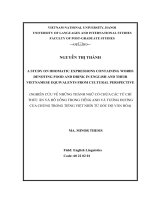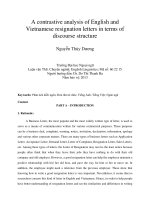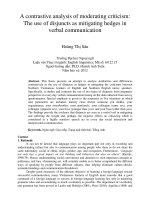A contrastive analysis of English perspective modals of necessity, certainty and ability and their Vietnamese equivalents from systemic functional perspective
Bạn đang xem bản rút gọn của tài liệu. Xem và tải ngay bản đầy đủ của tài liệu tại đây (151.4 KB, 5 trang )
A contrastive analysis of English perspective
modals of necessity, certainty and ability and
their Vietnamese equivalents from systemic
functional perspective
Nguyn Th Liên
i hc Ngoi ng
Lu English Linguistics; Mã s: 60 22 15
ng dn: Tun Minh
o v: 2010
Abstract. Modality is a topic of great interest for many grammarians. As far as the
traditional view is concerned, modality is defined as
(subjective) attitudes and opinions. When it comes to Systemic Functional Grammar, modality
refers to the area of meaning that lies between yes and no the intermediate ground between
positive and negative polarity. Despite the differences in the way they name, define or classify
modality, linguists of traditional and functional view agree with each other on that modal
auxiliaries are one of the most important means to express modality. In the light of Systemic
Functional Grammar, modal auxiliaries are characterized by the seven features. There is a fixed
list of modal operators which are ranked according to the values. In this thesis, the author have
no intention of covering everything about modal verbs or all their meanings. Rather, only the
modals with have done (called perfective modals) of three meanings - necessity, certainty and
ability are the concentrations of her analyses.
Keywords. Ting Anh; Ting Vit; ng t; Tr ng t tình thái
Content
1.1. Introduction
In recent years, linguists have turned attention from structural to functional linguistics.
Greater attention has been paid to the power of language as a tool of communication and areas of
me meanings has expanded to include not only
representative but also modality.
Nevertheless, the area of modality is rather harder to define, as has been demonstrated by
Palmer (1986). Similar notions of modality still live on in certain branches of linguistics. The
notional category modality is grammatically realized very diversely throughout the sentence, in
modal verbs and adverbs. Despite the strong interests in them, the modals remain a high
controversial linguistic phenomenon. However, chosen for inclusion in this paper are grams with
uses that are associated with modality - necessity, certainty and ability.
According to Palmer (1986), English has a system of modal verbs: will, can, may, must,
which are available in non-finite and modalized
verbal groups. We have past realized by (secondary) have (in a non-finite form) and past particle.
(1970: 177).
Modal auxiliary verbs may sound easy at first but in fact, they are difficult. Making this
explicit to teachers and learners could reduce the teaching and learning burden. Hence, a crucial
requirement is the necessity to analyse perfective modals of necessity, certainty and ability in
sufficient depth. That is my preoccupation in writing this paper.
1.2. Rationale for the Study
Of all the languages in the world today, English deserves to be regarded as a world
be
by learning how to use a verb. It is, therefore, necessary to acquire a thorough knowledge of
verbs, among which the English modals seem to be used at high frequencies. Thanks to modal
verbs, the communication among people can be diversified and colourful because they can
bring emotions, attitudes or opinions into what they say by using modals. In fact, modal verbs
are not simple as thought. They may be considered to be easy for the beginners who just know
the meanings superficially. However, when we can command the language better, we find it
really difficult to use their distinctive features properly.
English modal auxiliaries have captured my attention since I was a university student. At
that time, the fact that the more frequently modals are used, the more errors are made urged me
modals of necessity, certainty and a
Paper was discussed taking the view of traditional grammar. As a part of M.A. program, I had
chance to study Functional Grammar, which caused a number of troubles for me in the beginning
but caught my fancy at the end. After this course, the topic for my thesis arose. That is analyzing
perfective modals of necessity, certainty and ability using Systemic Functional Grammar as the
theoretical framework.
Reviewing the literature, quite a lot of questions concern modality and modals but few
of them have yet been definitely answered. Several researchers and learners have made studies
of modality and modals in general rather than perfective modals. My paper does not yet offer a
complete and coherent picture but it reflects, in my opinion, some of the best efforts in that
direction.
All the three reasons mentioned above are my motivations to carry out this study.
1.3. Aims of the Study
It is my aim to focus on making some preliminary enquiries about modality and
modal verbs in English and Vietnamese. However, neither is my ambition to cover all the
things related to modality nor do I intend to deal with all aspects relating to each modal. In
view of the complexity of my subject matter, I will have to be eclectic and illustrate the
perfective modals of the three meanings of necessity, certainty and ability in the spirit of
functional grammar view in detail followed by their Vietnamese equivalents. Bearing these
aims and objectives in mind, I made every attempt to answer the following research
questions:
1. What is modality and how modality conceptualized in traditional grammar and in
Systemic Functional Grammar?
2. What are the modal verbs in English as seen from the light of Systemic Functional
Grammar and their Vietnamese equivalents?
3. How is modality of necessity, certainty and ability expressed by perfective modal
verbs and their equivalents in Vietnamese?
1.4. Scope of the Study
Studying all things about modality and modal verbs will be too broad themes and,
therefore, an impossible task for any researchers. For the feasibility of a minor M.A. thesis, I
narrowed the scope of my paper. Some preliminaries of modality and modal verbs are included in
the second chapter. Modality in English is not discussed in any branch of grammar apart from in
Traditional Grammar as the background and in the light of Functional Grammar as the focus. An
overview grasp of modality in Vietnamese is also mentioned in contrast. In the main chapter,
Chapter 3, I did not intend to investigate all the meanings of the modal auxiliaries. Rather, only
three meanings - necessity, certainty and ability were the concentration of my analyses. I did not
study these modals in general or simple modals but the modals with have done (called perfective
modals). My concern in the contrastive part was to find the equivalents in Vietnamese for those
modals in English.
1.5. Methodology of the Study
The methodology of the study was based on descriptive analysis and qualitative data
activities. The reference materials, after being collected or accessed, were selected, analyzed
and grouped into categories so that the subject can be described in detailed. Examples, tables
and figures were also provided to illustrate the description. For comparison, the writer applies
comparison of modal verbs expressing similar meanings in some examples in English and
Vietnamese.
1.6. Design of the Study
This study comprises four chapters: Introduction, Theoretical orientations, English
Perfective modals of necessity, certainty and ability from systemic functional perspective and
their Vietnamese equivalents, and Conclusion.
The first chapter introduces, gives reasons, states what the study is aimed at, identifies
the delimitation of the study, presents the methodology and the organization of the study.
Chapter 2 is mainly devoted to the theoretical dimensions of investigation, in which modality
and modals in English and Vietnamese are studied. This includes two main parts: Modality in
English and Vietnamese and Modal verbs in English and Vietnamese.
Chapter 3 is concerned with descriptions and analyses of the three meanings - necessity,
certainty and ability in English and Vietnamese equivalents.
The last chapter closes, briefly, with the summary, the discussion of the problems in
teaching and learning these modals and some suggestions for further research.
References
English
1. Alexander, L.G. (1992), Longman English grammar, Longman, England.
2. Anna, S. (1991), Functional Grammar, Routledge, New York.
3. Butler, C.S. (2003), Structure and Function, Part I: Approaches to simplex clause, John
Benjamins B.V., Philadelphia.
4. Downing, A. and Locke, P. (1992), A university course in English grammar, Phoenix ELT,
New York.
5. Fillmore, C. J. (1968), Lexical entries for verbs, D. Reidel, Dordrecht, Holland.
6. Freddi, Functional Grammar: An introduction for the EFL student, D.R. Miller (ed.), pp.
89-100, Functional Grammar studies for Non-native speakers of English Series.
7. Goossens, L. (2000), Patterns of meaning subjectification,
and modal shifts, in A. Barcelona (ed.), Metaphor and metonymy at the crossroads: a
cognitive approach, Mouton de Gruyter, Berlin.
8. Halliday, M. A. K. (1970), Language structure and language function. New Horizons in
Linguistics, John Lyons (ed.), pp. 140-164. Harmondsworth, England.
9. Halliday, M. A. K. (1994), An introduction to Functional Grammar: Second edition,
Arnold, London.
10. Halliday, M.A.K. (2005), Studies in English language, Jonathan J. Webster (ed.), pp. 164-
190, Continuum, New York.
11. Halliday, M. A. K., and Hasan, R. (1976), Cohesion in English, Longman, London.
12. Hannay, M. and Steen, G. J. (2007), Structural Functional Studies in English grammar,
John Benjamins B. V., Philadelphia.
13. Hart, C.W. (1999), The ultimate phrasal book, Library of congress Cataloging-in
Publication Data, New York.
14. Hogg, R.M. et al. (1998), The Cambridge history of the English language, Suzanne
Romaine (ed.), Cambridge university press, New York.
15. Huddleston, R. and Pullum, G. (2002), The Cambridge Grammar of the English language,
Cambridge university press, Cambridge.
16. Jackson, H. (1990), Grammar and meaning: a semantic approach to English grammar,
Longman, London.
17. Jacobs, R. A. (1995), English Syntax A Grammar for English Language Professionals,
Oxford university press, Oxford.
18. Kress, G. (1981), Halliday: System and function in language, Oxford university press,
Hong Kong.
19. Lock, G. (1996), Functional English Grammar: An introduction for second language
teachers, Cambridge University press, Cambridge.
20. Lyons, J. (1977), Semantics, 2 vols, Cambridge University Press, Cambridge
21. Matthiesseen, C. (1995), Lexicogrammatical Cartography: English systems, International
Language Sciences Publishers, Tokyo.
22. Palmer, F. R. (1986), Mood and modality, Cambridge University Press, England.
23. Palmer, F. R. (2001), Mood and modality, second edition, Cambridge University Press,
Cambridge.
24. Swan, M. (2005), Practical English Usage, third edition, Oxford university press, Oxford.
25. Thompson, G. (1996), Introducing Functional Grammar, Arnold, London.
26. Van Valin, R.D. and LaPolla, R. J. (1997), Syntax, structure, meaning and function,
Cambridge University Press, Cambridge.
27. Verghese, C.P. (1989), Teaching English as a second language, Sterling publishers Private
limited, New Delhi.
Vietnamese
28. Dip Quang Ban (1998), Ng pháp ting Vit, tp 2, Nhà xut bn giáo dc, Hà Ni.
29. Cao Xuân Ho (1991), Ting Vio ng pháp ch, Nhà xut bn khoa hc xã
hi, Hà Ni.
30. Cao Xuân Ho (2004), Ting Vio ng pháp ch, Nhà xut b
,
Hà Ni.
31. Cao Xuân Ho (2006), Ting Vio ng pháp ch, , Nhà
xut bn giáo dc, TP H Chí Minh.
32.
(2008),
, .
33. (1999), ,
99, tr. 89-95,
t Nam,
, .
34. Bùi Trng Ngoãn (2002), Vai trò cng t i vi hành vi ngôn ng, Ng hc
tr 2002, tr. 192-202, Hi ngôn ng hc Vit Nam, Hà Ni.
35i ching t tình thái trong ting Anh vi ting Vit, Ng
hc tr 2000, Hi ngôn ng hc Vit Nam, Hà Ni.
36.
(1977), , .
37. Nguyn Th Thun (2002), u v các t tình thái nên, cn, phi trong câu, Ng hc
tr 2002, tr. 236-242, Hi ngôn ng hc Vit Nam, Hà Ni.
38. Nguyn Minh Thuyt and Nguyp (1998), Thành phn câu ting Vit, Nhà xut
bi hc Quc gia Hà Ni, Hà Ni.









